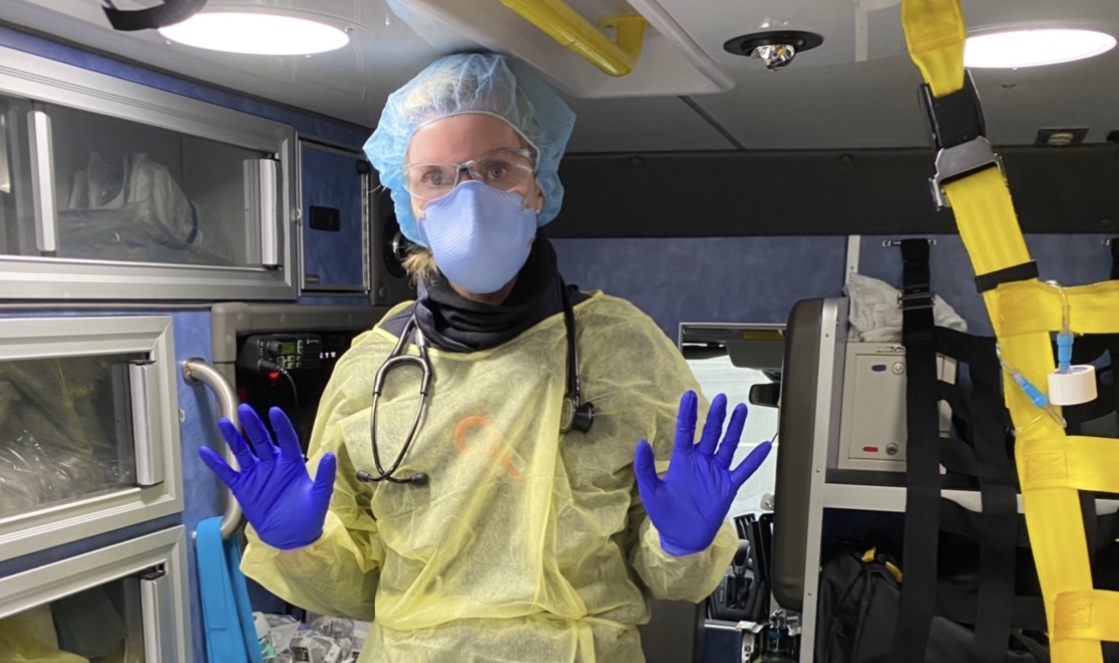Imogen Rawlings-Green, Editor
@irawlingcourant
During these unprecedented times, our first responders are adapting to the changing challenge of the COVID-19 pandemic. Now going to work with a masked smile, they must take extreme measures to protect themselves, their families, and their patients. The Emergency Medical Services (EMS) world is bursting with heroes, tireless newcomers, old comers, parents, and even students that are adapting to a new kind of change. Such change requires a new outlook and improved responses to protocols. How exactly is the EMS community in New York, Bridgeport, and New Canaan improving their protocols, personal protective equipment (PPE), and response to overwhelmed hospitals in this pandemic?
Protocols
For one emergency medical technician (EMT) deployed into Brooklyn, New York for 35 days by the Federal Emergency Management Agency (FEMA), her entire scene and response to 911-calls changed. “We go to base in the morning, get restocked, clean the ambulance if needed, get briefed on what task we have for the day, and head out to do 911s. The briefings are done by the chiefs and the rest of the higher-ups,” she said. “When we get a call we treat everyone like they have COVID-19. We double up on masks, gown up, and gloves on. It’s literally like going into a war zone.”
In all areas, protocols have enhanced safety precautions for both the EMS crew and patients. Bridgeport EMT Kevin Burwell, involved in EMS for 28 years, explains how his situation has changed. “We are wearing masks at all times. We are medically screened now before reporting for work,” said Mr. Burwell. “And every shift is exponentially more stressful due to the risk I am taking.”
Similarly, in New Canaan, protocols have improved to wearing full personal protective equipment (PPE), social distancing, sanitizing headquarters, and equipment. “I think the protocols have changed so that we make sure that we and our partners and crew members feel safe and are safe,” a New Canaan EMT for 40 years, Tracy Evans, said. “What we are taught from day one is that the scene must be safe and that scene extends to our homes and our families.”
Personal Protective Equipment (PPE)
For many EMS crews, extra equipment was ordered as early as January including surgical masks, N95 masks, gowns, face shields, gloves, and booties. Even so, personal protective equipment has become a rationed commodity among first responders. “In normal times, we would change our mask after every call or every patient,” said Ms. Evans. “And these days we seem to have to re-wear masks several times.”

“Sometimes we go through equipment like crazy and the demand is high” said a New York EMT. “But we have been given what we need.”
A 20-year New Canaan EMT Bonnie Rumilly explained that the Town Leadership and the New Canaan Emergency Operations Center (EOC) has provided amazing support to New Canaan EMS in allowing EMTs to feel protected.
Number of Calls & Hospitals
In terms of daily calls, Mr. Burwell estimates 70% of his calls are COVID-19 related and his company responds to about 35-40 plus possible COVID-19 patients every day. “The call volume is down for other types of calls such as routine transfers, but COVID-19 calls are increased,” said Mr. Burwell. “I can’t speak on behalf of the hospitals, only what I’ve seen. The ICU departments are full. The staff is exhausted. Not overwhelmed by the patients, but by the risk they take.”
Ms. Evans explains the situation she is noticing as a result of the ongoing virus: “In the beginning, the same number of people were going to the hospital for the same complaint. Many patients who go to the emergency department don’t actually have an emergency, they go there for care because it’s available 24 hours. This is a culture of instant gratification, so they go because it is a pain to wait to get in to see a doctor or because they are a vulnerable population such as elderly, disabled, foreign language speaking, and they don’t have access to regular care so the emergency department is a safety net. Initially the volume was much higher, forcing hospitals to put tents up outside to pre-screen. Then the word got out that the hospitals have patients who are positive for COVID-19. Fortunately, a lot of people who didn’t need to be there stopped coming. But, sadly, a lot of people with emergencies; heart attacks, strokes, chest pains, surgical emergencies like appendicitis or gallbladder attacks, bowel obstructions, stopped coming out of fear and they started dying at home. It is starting to slow now, but here in the local emergency department almost every patient they have is COVID positive today,” Ms. Evans said.
Ms. Evans said now that things are starting to slow down, some are fearful of a second wave and must emphasize the importance of treating every patient as though they have COVID-19. She explains that patients who are asymptomatic can be just as dangerous as patients who are symptomatic.
An EMT working in New York gives advice and perspective to the overall situation hospitals are facing. “Don’t go to the hospital unless you absolutely have to because they are overcrowded,” she said. “Call your doctor if you have any questions.”
While this pandemic has resulted in tragedy, one takeaway is the drastic improvement of protocols for the safety of both responders and patients. “We are all laser-focused and working very hard to ensure safety,” Ms. Rumilly said. “There is a degree of somberness overall, as we are saddened by the losses of life and people ill with the virus. We, like everyone else, miss being out in the community enjoying the freedom and our local businesses. But we remain hopeful for the future.”




